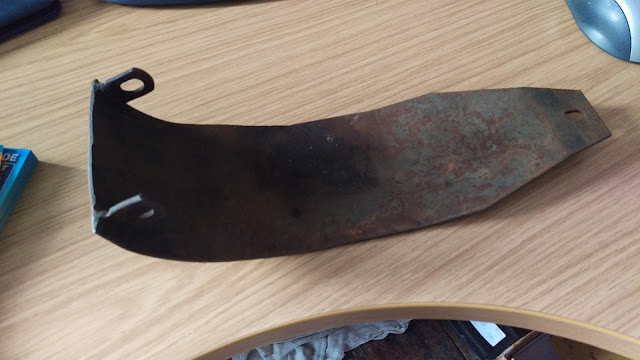I mentioned in the last post that there were a couple of things I wanted to sort out before the W/NG goes back on the road. When I refitted the clutch cable I found it was mysteriously too long - strange in that apart from replacing the missing thrust bearing everything is the same as when it came apart. Investigating, I found the clutch adjuster was missing, having been replaced by this homemade one:
Thursday, 29 October 2020
W/NG - last bits before she goes back on the road
Tuesday, 27 October 2020
W/NG - first start after engine rebuild
And there she goes:
Just a few bits left - the decompressor is not adjusted correctly and the clutch adjuster is a home made one I'd like to replace.
Friday, 23 October 2020
W/NG - Oil pressure
One of the more hair-raising aspects of rebuilding an engine is making sure the lubrication system is working before you go out on it. You fire it up, and then hold your heart in your mouth waiting for the spurts of returning oil coming into the tank to tell you that all is well.
Thursday, 22 October 2020
Charlie's shed - Making bolts
Pulling the rocker box off the exhaust side of the W/NG engine revealed that the bolt I had planned to copy, to replace the missing one, was too short. Since that came from the same position on the inlet side, I now had two new longer bolts to make. According to the parts list, the rocker box bolts are 2 5/8" and 2 7/8", both 5/16" CEI of course.
Tuesday, 20 October 2020
W/NG - Primary drive & clutch assembly
Now that the engine is essentially finished, we can turn the whole bike round and reassemble the primary drive. There's not enough room in the workshop to get to both sides - there are five bikes, four of them Ariels, in here at the moment.
 |
Thursday, 15 October 2020
W/NG - Assembling and fitting the head
I finished the last post with the cylinder head paint drying, and I went and had a day on the railway which I recorded in this blog post so that now, the paint has been curing for a couple of days.
I've now managed to fit both rocker boxes without missing anything out! I've added the rocker oil line, and this time I have fitted a cable tie as shown in the parts book for this bike - it's very unusual to see these fitted.
There is still a rocker box bolt missing (two actually), which I will have to make. I've used the opportunity to introduce some oil into the rocker box through this hole - this is not normally possible, but recall that this hole has a chunk broken out of the head and so provides a passage from the bolt hole into the head and down into the pushrod tube. The objective is to get some oil onto the camshaft.
Tuesday, 13 October 2020
W/NG - Interlude to engine assembly: fitting the bash plate
I've had the bash plate for the W/NG sitting around for over two years. I bought it on eBay, but I have never fitted it because they are an absolute pain to get on. Here it is, in original paint:


















































